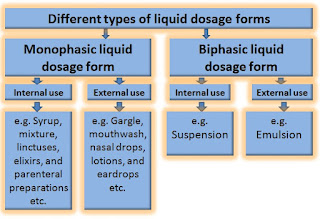A liquid dosage form is a type of dosage form, classified based on the physical state and is intended for internal, parenteral, and external applications.
The dosage forms are pharmaceutical formulations in which a specific mixture of active pharmaceutical ingredients and excipients is presented in a unique configuration to provide precise and easy administration and delivery of the medication.
As medication is only effective when they reach their site of action hence the different types of dosage forms are available and that are classified based on the method/route of drug delivery or based on their physical form. Oral, topical, inhalation, parenteral, and rectal route of administration are the dosage forms which are classified based on the route of drug administration. Solid, liquid, semi-solid, and gaseous dosage forms are the dosage forms that are classified based on physical form.
|
Table of contents Types of liquid dosage forms |
The liquid dosage form is one of the oldest dosage forms formulated to release the active principle instantly after oral administration and to obtain high absorption of the medication. The liquid dosage forms are most useful for individuals who have difficulty swallowing solid dosage forms such as tablets, capsules, granules, caplets, and powders, and in cases where precise, individual doses are needed.
Liquid dosage forms are formed by dissolving drugs in aqueous/non-aqueous solvent, including emulsions, suspensions, solutions, etc. It also requires different excipients and agents to formulate, including stabilizers, preservatives, vehicles, sweeteners, viscosity builders, colors, and flavors agents are used.
Types of liquid dosage forms:
Liquid dosage forms are classified into two parts according to phase i.e. Monophasic liquid dosage form and biphasic liquid dosage form.
Monophasic liquid dosage form:
The monophasic dosage form is the simplest form to introduce medicine for rapid and high absorption of pharmaceutical active ingredients. It is a single-phase system containing two components i.e. solute and solvent. The solute is a component that dissolves and the solvent is a medium in which solute dissolves.
Monophasic liquid dosage forms are classified into the following types.
- Monophasic liquid dosage forms for external use: e.g., liniments, and lotions.
- Monophasic liquid dosage forms for oral use: e.g., syrups, mixtures, drops, linctuses, elixirs, and draughts.
- Parenteral solutions: intravenous, intramuscular, or subcutaneous injections
- Monophasic liquid dosage forms for a particular use: e.g., mouthwashes, douches, gargles, nasal drops, eye drops, ear drops, eye lotions, throat paints, inhalations, aerosols, and sprays.
Biphasic liquid dosage form:
A biphasic system consisting of a dispersed state solid whereas a continuous phase liquid that can be oily or aqueous and the system is stabilized by the addition of an agent called a suspended agent.
The biphasic liquid dosage form is used when the drugs are poorly soluble in the solvent. Drugs from the dispersed phase of the system can be either liquid or solid, when the solid API is distributed into the dispersion medium, the system formed is called a suspension. When liquid medicine is distributed in the dispersion medium, the system form is called emulsion.
Biphasic liquid dosage forms are classified into the following types.
There are two types of biphasic liquid, suspension, emulsion.
- Suspensions are categorized into- applications, inhalation, enemas, lotion, eye drop, and aerosols, etc.
- Emulsions are categorized into- application, lotion, liniment, and enemas, etc. Emulsions are of two types-oil in a water type (o/w) and water in an oil type (w/o).
Advantages of liquid dosage forms:
- Liquid dosage forms are the most suitable for patients (child and elderly) who have difficulty swallowing solid medicine.
- Absorption occurs faster than solid dosage forms.
- The unpleasant taste and odor of active pharmaceutical ingredients (API) can be removed by adding sweetening and flavoring agents in the formulation.
- As compared with other dosage forms the liquid dosage forms can provide greater flexibility in obtaining the appropriate dose of the drug.
Disadvantages of liquid dosage forms:
- It has a shorter shelf life due to the nature of the liquid and less stable than other dosage forms.
- Since it is bulky therefore difficult to handle, transport and store.
- Difficult to formulation compared to solid dosage forms.
- The exact dose may vary each time as it needs to be measured.
Commonly asked questions on dosage forms are as follows.
What are the types of oral liquid dosage forms?
Oral liquid dosage forms in pharmaceuticals including syrup, oral suspension, oral drop, oral solution, mixture, oral emulsion, elixir, and linctus, etc.
What is the importance of dosage forms?
Dosage forms are required to protect the drug from atmospheric conditions such as temperature, humidity, to improve therapeutic activity, and for patient compliance.
What are the different routes of drug administration?
To introduce the drug into the body the different routes are used according to the site of action. The oral route, mucosal route, parenteral route (injection), topical route, inhalation route, pulmonary route, otic route, and sublingual/ buccal route are the routes of administration.
What are the different types of tablet coating?
Sugarcoating, film coating, compression coating, enteric coating, gelatin coating, and other types of coating are the types of tablet coating are used according to the properties and nature of tablets.

No comments:
Post a Comment